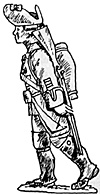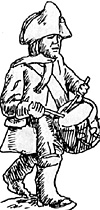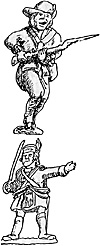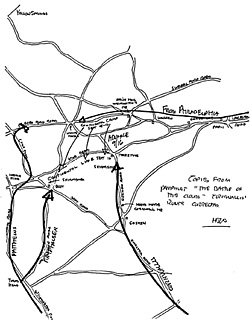Between the battles of Brandywine and Germantown there occurred an oddity of military history, a major engagement which did not take place. This non-event has gone down in history as the Battle of Goshen, or the Battle of the Clouds.
 Following Brandywine the American Army. beaten but not discouraged, retired on Chester. Here,
while the officers worked to sort out disorganized units, Washington planned his next move. At 4:00 am on the 12th the Army left Chester marching north east towards Dover. It crossed the Schuykill at the Middle Ferry then passed through Philadelphia. By 9:00 am it had returned to its old camp at the Falls of Schuykill, six miles north of the city. Here the soldiers received a much appreciated 'thirty hogsheads of rum' distributed 'to each officer and soldier one gill per day while it lasts' and some rest.
Following Brandywine the American Army. beaten but not discouraged, retired on Chester. Here,
while the officers worked to sort out disorganized units, Washington planned his next move. At 4:00 am on the 12th the Army left Chester marching north east towards Dover. It crossed the Schuykill at the Middle Ferry then passed through Philadelphia. By 9:00 am it had returned to its old camp at the Falls of Schuykill, six miles north of the city. Here the soldiers received a much appreciated 'thirty hogsheads of rum' distributed 'to each officer and soldier one gill per day while it lasts' and some rest.
While Washington's men marched Howe fell prey to one of his strange bouts of inertia. Ignoring the Americans his army camped on the battlefield near Dilworth. There it stayed until the 12th when Grant, with 1st and 2nd Brigades, marched to Concord Meeting two miles east of Dilworth, and the 71st Regiment (Fraser's Highlanders) was ordered south to take possession of Wilmington. On the 1 4th the wounded followed the 71st to Wilmington.
After Washington
On the 13th Cornwallis, with the Light Infantry, the Grenadiers and the Queen's Rangers, was ordered east after Washington. Picking up Grant and his brigades at Concord Meeting Cornwallis advanced on Chester. Finding the Americans long gone he encamped just outside the town at Village Green. While the British were dithering Washington reviewed his position. The Army was safc, but it was on the wrong side of the river. It could not properly defend the fords of the Schuykill and, equally important, could not defend the military stores collected in northern Chester County. On 9:00 am on thc 14th the Continentals broke camp and marched two miles to Levering's Ford. Here they recrossed thc Schuykill 'the water being nearly up to the waste' picked up the Lancaster Road and that evening camped at Buck's Tavern.
The Order of March from Germantown on the 1 4th was: Part of the Light Dragoons, part of Smallwood's Brigade, Sullivan's Division, Lord Sterling's Division, Wayne's Division, Park of Artillery, Nash's Brigade, Steven's Division, Greene's Division, wagons with stores, part of Weedon's Brigade, and the remainder of the Light Dragoons.
 At 6:00 am on the 15th the march resumed. On reaching the Whitehorse Tavern the van turned
south and camped, forming, the right of the Continental line. The rear, now near Warren Tavern, also turned south to form the left. It was not until the 15th, Howe, having finally received some news or Washington's movements, decided to move. Riding with his staff to Village Green he met with Cornwallis. At this conference it was decided the Army would move north. Having the longest distance to go Cornwallis broke camp at 12:00 pm on the 15th.
At 6:00 am on the 15th the march resumed. On reaching the Whitehorse Tavern the van turned
south and camped, forming, the right of the Continental line. The rear, now near Warren Tavern, also turned south to form the left. It was not until the 15th, Howe, having finally received some news or Washington's movements, decided to move. Riding with his staff to Village Green he met with Cornwallis. At this conference it was decided the Army would move north. Having the longest distance to go Cornwallis broke camp at 12:00 pm on the 15th.
His troops then began to advance up the Chcstcr Road towards Goshen Meeting. Sergeant Sullivan reports this march was 'a tedious movement and frequent halting an account of the night being very dark, and the two divisions keeping a communication one with another'. In spite of his difficulties Cornwallis moved faster than Howe and had to halt for a time outside Goshen Meeting for Knyphausen to come abreast. After sending the Mirbach Regiment to reinforce Wilmington Howe, with Knyphausen, left Dilworth and moved up the Wilmington Road towards Turk's Head (now West Chester), a distance of about five miles.
On reaching Turks Head, some shots were fired at the column and 'a soldier of the 33rd Regiment was killed'. Here Howe made a decision which might have won the war. He divided his command sending a column under Knyphausen up the road to Boot Tavern and a second column under Matthews up Reading Road towards Indian King Tavern.
Sometime after 11:00 am on the morning of the 16th Pulaski reported Cornwallis' advance to Washington. Deciding to fight, Washington ordered the Army up the South Valley Hills into a position along the crest and began to form Line of Battle along the Indian King Road. The line ran from Boot Tavern on the right to Three Tuns Tavern on the left, a distance of about three miles. As the Continental line was never fully formed it is not certain how the troops were placed. A map of the site suggests this order of battle:
Armstrong's Division (to the right of Boot Tavern), Stirling's Division, Stephen's Division, Sullivan's Division, Proctor's Division and Greene's Division. Wayne commanded the light troops with Maxwell's Brigade on the right and Pulaski's Legion on the left.
Opening Shots
By 1:00 pm Cornwallis' troops began to arrive on the American left. T o delay the British Washington ordered Pulaski., commanding a mixed force of cavalry and militia, to take an advanced position on high ground behind Hershey's Mill. Here he was attacked by the British 1st Light Infantry and, much to Wayne's disgust, the militia shamefully fled the first fire. Having cleared his front Cornwallis began to form his line as his troops came up the Chester Road. About the same time the American right became engaged when 'the Chasseurs and the 2nd Battalion of light infantry in front, of Lieut. General Knyphausen's column, fell in with 500 Pennsylvania militia which lay in a wood to obstruct our march'. The militia retired after 'exchanging a few vollies'.
 Leading the Hessian Jaegers v Donop follow the militia. He followed to far and came close to being cut off by Maxwell. Retiring quickly the Jaegers formed line with the Hessian Grenadiers and advanced on Maxwell, who had taken a position 'of high ground covered with cornfields and orchards.' After a number of vollies the Americans 'retired to a dense forest.'
Leading the Hessian Jaegers v Donop follow the militia. He followed to far and came close to being cut off by Maxwell. Retiring quickly the Jaegers formed line with the Hessian Grenadiers and advanced on Maxwell, who had taken a position 'of high ground covered with cornfields and orchards.' After a number of vollies the Americans 'retired to a dense forest.'
By 1:00 pm a major battle was in the offing. Lines of Battle were forming along parallel ridges and skirmishing had taken place on the flanks. On the surface Washington's position was a strong one. The Army was established on a ridgeline with a parallel road to its rear and its center shielded by 'a valley of soft wet ground, impassable for artillery'. A position not unlike Wellington's at Busaco. Cornwallis and Knyphausen could be handled. But what of Matthews? Matthews column had passed Indian King Tavern and was advancing on Cart Road, well to the rear of the Americans.
At Brandywine the Continentals had shown a surprising ability to maneuver. But there the troops redeployed had not been engaged. What would happen here with the right and left heavily engaged and Matthews' troops attacking from the rear? At best a severe defeat and at worst the destruction of the Continental Army was in the offing?
Weather Effects
Then, just as Washington ordered Scott to attack Cornwallis, a miracle saved the Americans. The weather had changed. By the 13th the heat of Brandywine had been replaced by 'a hard North West wind'. By the 15th the wind shifted to the northeast and on the 1 6th the sky was overcast with light rain. Shortly after 1:00 pm the storm broke. An unbelievably heavy rain quickly turned the battle ground into a quagmire.
Major Baumeister wrote to: 'Right Honorable Lord, Gracious and Mighty Colonel von Jungkenn; I wish I could give you a description of the downpour. It came down so hard that in a few minutes we were drenched and sank in mud tlp to our calves.' The rain ended all thoughts of battle. The British, who might have continued with the bayonet, were stopped by the rain and mud. 'Our column drew up in three Lines, expecting the Enemy to advance and attack us, but it continued raining so hard that we were all wet to our skin, and not able to fire a shot, our Arms being very wet. We remained in the Wood all night, notwithstanding it being raining until 8 o'clock next morning.' The Americans, for the most part without bayonets, could only retire.
By 4:00 pm the Continentals formed on high ground north of White Horse Inn then began to slog through the mud and rain to Yellow Springs. In the words of Lt. McMichael 'This march for excessive fatigue surpassed all I ever experienced!'
At Yellow Springs Washington believed he could reform and offer battle. He reported to Congress 'At first I expected that the loss [of ammunition] was by no means so considerable and intended [only] to file off with the Troops a few Miles to replace it and clean their arms.' However, now it was found poorly made cartouche boxes had allowed the rain to ruin 400,000 cartridges, the Army's entire supply. The Army had to retire on the magazines at Reading Furnace. The British did not begin to move again until the afternoon of the 17th, by which time the Americans were well beyond their reach.
Order of Battle
The British:
General William Howe Commanding (1)
LTG v Knyphausen's division:
- 16th Light Dragoons: 3 squadrons 319 (2)
Rifles: CPT Ferguson 130 Artillery: BG Cleveland 400 (3)
- Guards: BG Matthews 887 (4)
1st & 2nd batts
- 15th, 17th, 42nd, 44th regts.
- 33rd, 37th, 46th, 64th regts.
Hessian Grenadiers: 1307
Linsing, Minnigerode, Lengerke batts.
MG Cornwallis' division:
- Queens Rangers: MAJ Wemys 398 (6) Grenadiers: 1080
1st & 2nd batts. Light Infantry: BG Leslie 1130 (6)
1st & 2nd batts.
- 4th, 23rd, 28th, 49th regts.
- 5th, 10th, 27th, 40th, 55th regts.
TOTALS: 13507
600 (2000) (7)
12907 (11507)
1. Either records were poorly kept or the British were very free in transferring troops between brigades. None of the OBs I have agree. The OB above is from Brandywine with the changes known to have occurred before the 16th.
2. It is not known how many of the dragoons were mounted. Few of the horses embarked at New York having survived the voyage. Many of those who were mounted purchased their horses from Continental dragoons who deserted to the British, sold their horses and deserted again to the Americans!
3. I have been unable to determine how many guns either army had. My best estimate is about 32 each at Brandywine. Here the Americans lost eleven, two of them brass guns taken at Trenton, many when the horses were killed and the guns could not be withdrawn. This would give the British 32+ guns and the Americans 20+ on the 16th.
4.a. The Guards Brigade was formed by drafting fifteen men from each of the companies of the three Foot Guard Regiments. The levy was formed into two battalions on reaching America.
b. l have been unable to determine the composition of Matthews column. My best estimate is the Guards and 4th Brigade. CPT (later MAJ) Andre notes on the 16th, 'The 3rd Brigade, Battalion of Donop, and the Rangers covered the baggage which from the badness of the road could not get up that evening.'
5. The Combined Regiment was formed from the remnants of the Trenton regiments, Lossberg, Knyphausen and Rall.
6. The Queens Rangers and the 2nd Light Infantry, with Cornwallis on the 14th, were transterred to Howe, possibly in the early morning of the 16th.
7. Losses at Brandywine as per Howe/v Knyphausen vs ( ) the Marquet document.
The Continentals:
General George Washington Commanding: Light Dragoon Brigade:
- Bland's, Sheldon's, Byrd's, White's regts. 800
Maxwell's Brigade: BG Maxwell (8)
Pulaski's Legion: BG Pulaski (9)
Artillery: BG Knox 1300 (3)
- Pa, Cont, Ma, regts and NJ, NY, Msc, cos.
1st Division: MG Greene 1700 1st Virginia Brigade: BG Muhlenburg
- IVa, 5Va, 9Va, 13Va regts.
- 2Va, 6Va, 10 Va, 14Va, Pa State regts.
2nd Division: MG Stephen 1700 3rd Va. Brigade: BG Woodford
- 3Va, 7Va , 11Va, 15Va regts.
- 4Va, 8Va, 12Va ,Grayson, Patton's regts.
3rd Division: MG Sullivan 1300 1st Maryland Brigade: (BG Smallwood) (10)
- 1Md, 3Md, 5Md, 6Md, Delaware regts.
- 2Md, 4Md, 7Md, German, Hazen's regts.
4th Division: COL Procter 1600 (12) 1st PA Brigade: COL Hartley
- 1Pa , 2Pa, 7Pa, 10Pa, Hartley's regts.
- 4Pa, 5Pa, 8Pa, 11Pa regts.
5th Division: MG Lord Stirling 1800 3rd PA Brigade: BG Conway
- 3Pa, 6Pa, 9Pa, 12Pa, Spencer's NJ regts,
- 1NJ, 3NJ regts. (13)
Pa Militia Division: MG Armstrong 3000 1st PA Brigade: BG Potter - 7 county regts 2nd PA Brigade: BG Irvine - 6 county regts Total 14000
8. In early August Maxwell was ordered by Washington to recreate the corps of light infantry sent north with Morgan. One hundred men were withdrawn from seven brigades to form the unit. Sullivan's Division was not initially tapped for it was marching from New Jersey and did not rejoin the Army until August 29. Maxwell's light infantry totaled some 600 to 750 men. But as these troops came from established units the Brigade did not add to the Army's strength. Maxwell held this command until shortly before the Army entered Valley Forge where he again commanded the NJ Brigade.
9. A mixed force of light dragoons and infantrymen.
10. Away from his Brigade recruiting in Maryland.
11. The Brigade commander at Brandywine, BG de Borre, 'fled ignominiously' with his men. He left the country for France one short step ahead of a Court Martial.
12a. The 4th. Division was originally commanded by MG Lincoln. When this officer was sent north to help contain Burgoyne command was first by Sullivan then by Wayne. With Pennsylvania's quota of Major Generals was filled it was some time betore Wayne assumed the appropriate rank. The Division was described as Lincoln's as late as the Philadelphia review on August 23. Its first designation as Wayne's appears to be in General Orders issued at Darby on August 25.
b. With Wayne commanding the light troops temporary command of his division devolved on thc next senior officer, COL Procter of the PA Artillery. 13. Away from his Brigade commanding the Light Infantry Brigade.
In the absence of their commanders Smallwood's, Maxwell's and de Borre's Brigades were probably commanded by their senior Colonels.

The Numbers
The British:
On Monday morning, August 25, 1777, the Royal Navy began landing 15,000 to 18,000 soldiers, 13799 of whom are described as privates; 'in good health and spirits, admirably' supplied with all the implements of war and lead by an experienced general of unquestionable military talents' From August 25 through September 16 the British Army received neither reinforcements nor replacements. It did suffer losses.
Howe reported a loss of 24 officers and men from the Cooch's Bridge fight and 576 from the Battle of Brandywine. (Knyphausen reported 622). It was not unusual though for Howe, or any general, to under report his losses. After Cooch's Bridge a British camp follower deserting the Americans described nine wagon loads of wounded sent down to the fleet. At Germantown a British officer named Marquet fell into American hands with a state of forces disposition in his possession. The report below is taken from the 'History of Chester County.'
State of British forces and disposition Sept. 11, 1777
At the upper Fords under-the command of Lt. Cornwallis:
2nd Regt British Guard: 1740 (k&w : 612)
2nd Regt Light Infantry
2nd Brigade British: 2240 (k&w: 360)
1st Brigade Hessians: 800 (k&w60)
Fargason's Riflemen: 80 (k&w46)
Total: 4860 (k&w: 1078)
Middle Ford under Maj. Gen. Gray:
2 Battalions of Guards 500
2 Bns and 42 Rgt Highlanders 700
2 Bns and 71 Regt Highlanders 700
Total: 1900
Lower Chads Ford under the command of Knyphausen:
2 Brigades of British consisting
4th, 5th, 15th, 23rd, 27th, 28th, 40th, 49th, 55th: 2240 (k&w 580)
1st Brigade Hessians: 800 (k&w 28)
Queen Rangers: 480 (k&w 290)
Grand Total: 10280 (k&w: 1976)
In his history Mr. Pleasants writes of the British following Brandywine, 'Certainly there seemed to be little inclination on the part of General Howe to take advantage of clear way towards northern Chester County. The inference is logical that either his army had taken severe punishment and was unable to move or else that Howe was guilty of an error in tactical judgement.' If the Marquet document is correct the reason for Howe's inaction is clear. The Army had been mauled.
Factoring in the numbers above, using the Brandywine OB, ignoring the sick and stragglers, subtracting known detachments and assuming most of the casualties were privates on the 16th Howe could field 12907 (his figures) or 11907 (Marquet numbers).
The Americans:
After a visit to Washington's camp on about August 1, 1777 a committee of Congress reported the Army's strength as 17,949 men of whom 16,920 were fit for duty and of these 14,049 were privates. At Brandywine, the Army's strength was estimated as 15,000, including the militia. Of this number Chief Justice Marshall, who was present at the battle, estimated the effective force at 11,000 also including the militia.
American casualties at Brandywine are poorly documented . No formal report of their number was made by Washington. In his own report to the President of the Massachusetts Council, Knox estimated the Americans lost 700 to 800 killed, wounded and missing. Whatever the losses were they appear to have been quickly replaced with militia rallying to the Army in Philadelphia.* In numbers, if not in experience, Washington's army was probably as strong on the 16th as it had been on the 11th and may have outnumbered Howe's British.
*While I have found no evidence troops from the Wilmington garrison joined Washington it does not appear unlikely. Wilmington was abandoned without loss on the 12th and its garrison, Col. Irving's Brigade, were Continentals of the Pennsylvania Line.
Back to MWAN #85 Table of Contents
© Copyright 1997 Hal Thinglum
This article appears in MagWeb (Magazine Web) on the Internet World Wide Web.
Other military history articles and gaming articles are available at http://www.magweb.com